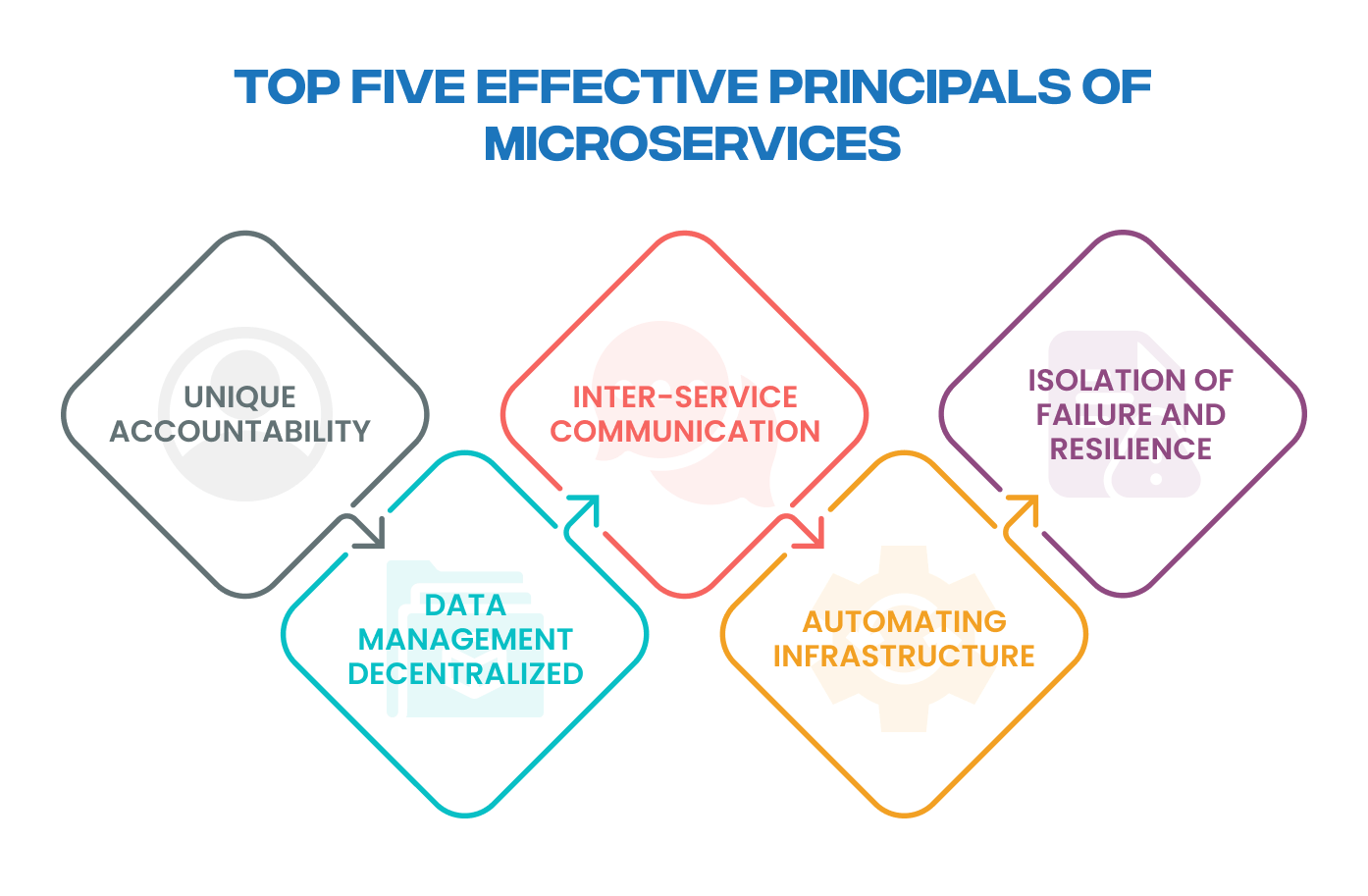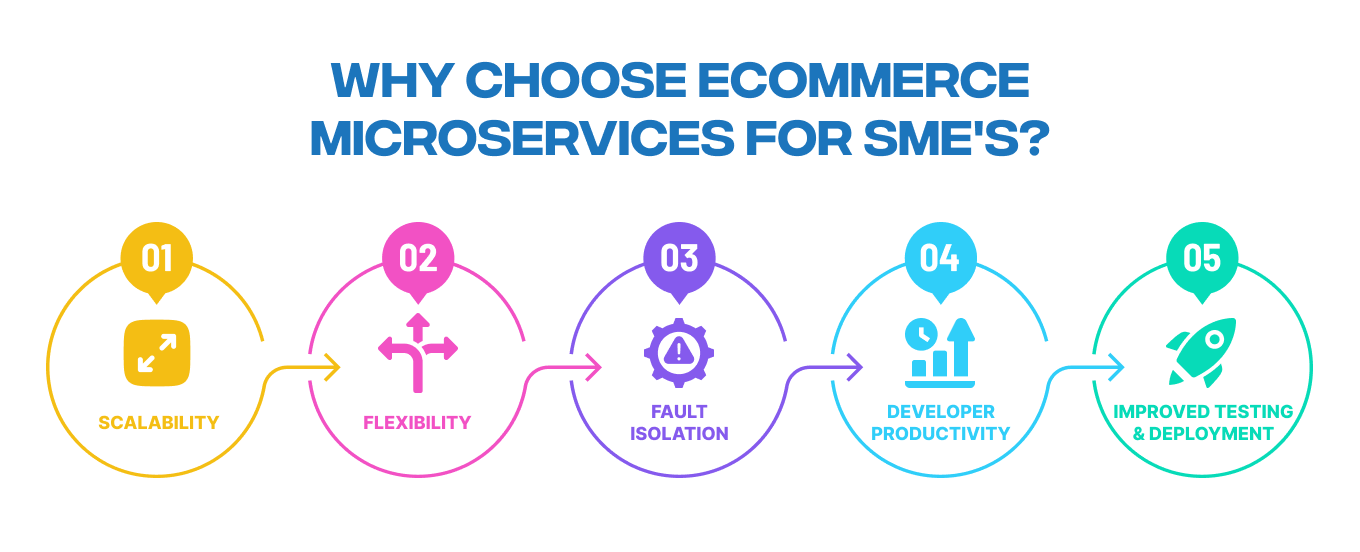Greetings and welcome to our in-depth blog about microservices in the eCommerce space Microservices have transformed the eCommerce industry, allowing businesses to embrace agility and scalability while delivering outstanding customer experiences. This blog will examine how microservices Architecture for eCommerce have developed in the eCommerce website solution sector, examine their concept and design, contrast them with service-oriented architecture (SOA), and go over the fundamental ideas that underpin them. So, let’s get started on this and discover more about how microservices have transformed the eCommerce industry.
Microservices’ Evolution in eCommerce
Over the last ten years, eCommerce has expanded at an exponential rate, necessitating the need for scalable and adaptable systems. Many eCommerce systems are powered by traditional monolithic designs, which are often prone to bottlenecks and make it difficult to add new features or extend the system horizontally.
The industry focused on microservices, which provide a decoupled and modular approach to software development, after realizing these difficulties. 90 % of new digital business apps by 2025 will use microservices architectures, predicts Gartner study. This figure demonstrates the importance and quick uptake of microservices-based architecture in eCommerce.
What are Microservices in eCommerce?
As the name implies, microservices are discrete, standalone services that combine to create a complete, functioning application.
- Every microservice can be independently built, deployed, and scaled, and each one is in charge of a certain business feature.
- Numerous benefits come with this modular approach, including improved fault isolation, better agility, and simpler continuous integration and deployment.
- The program is split up into several independent services in a microservices architecture, and these services talk to one another using lightweight protocols like message queues or REST.
Teams can operate independently on separate services because of this decoupling, using a variety of technologies and programming languages that are suited to the unique needs of each microservice.
eCommerce Microservices Architecture
The way online platforms are developed and run has changed dramatically as a result of the eCommerce sector’s embrace of microservices.
- Scalability, maintainability, and resilience can be increased for an organization by breaking down a monolithic application into smaller, more controllable services.
- The horizontal scalability of microservices architecture is one of its main features.
- Businesses can grow certain microservices that are in high demand rather than the full monolithic system.
- For instance, the payment microservice can be independently scaled to meet higher transaction volumes during periods of peak shopping, guaranteeing a smooth experience for customers.
- Furthermore, in omnichannel retail solutions, if one microservice fails, the application as a whole is not affected.
- Fault isolation is made possible by microservices’ decentralized architecture, which confines errors to the particular service in which they arise.
This speeds up the identification and resolution of problems and increases system stability. It also shortens the time it takes to provide bug patches and feature upgrades.
Service-Oriented Architecture (SOA) vs Microservices
Although modularization and decoupling are key concepts shared by both microservices and SOA, the two methodologies vary in important ways. eCommerce microservice architecture features are widely used in:
- Building closely connected services that usually interact over standardized protocols like SOAP is the main goal of SOA.
- Conversely, loose coupling and lightweight communication protocols such as REST are given priority in microservice architecture.
- Because of their autonomous deployment capabilities, microservices provide a finer-grained approach to service composition.
- By encouraging a decentralized organizational structure, they let independent development teams create, refine, and expand their microservices.
Conversely, SOA prioritizes enterprise-wide service orchestration and is often more centralized.
Five Essential Microservices Concepts
Let’s examine each of the five guiding principles of microservices architecture for eCommerce to better understand what they are.
Unique Accountability
Every microservice needs to be responsible for a single, clearly defined business capability. This idea guarantees that services will always be compact, highly integrated, and manageable.
Data Management Decentralized
Microservices should concentrate on data consistency inside their restricted context and manage their own specialized data storage. Headless eCommerce solutions prevent data duplication between services and permit autonomous data schema development.
Inter-Service Communication
Loose coupling is made possible by microservices interacting with one another over simple protocols like message queues or REST. Better concern separation, fault tolerance, and scalability are all encouraged by this idea.
Automating Infrastructure
To manage the microservices architecture for the eCommerce lifecycle, automation is essential. Microservices can be deployed, scaled, and monitored with agility thanks to DevOps techniques like containerization, continuous integration, and continuous delivery.
Isolation of Failure and Resilience
The resilience of microservices is built to withstand failures. Microservices can minimize the effect of failures on the system as a whole and recover gracefully by using methods like bulkheads, circuit breakers, and fallback mechanisms.
Organizations can fully use microservices and take advantage of the advantages they provide for their eCommerce systems by following these guidelines.
By offering a scalable and adaptable architecture for creating online platforms, microservices have completely changed the eCommerce sector. Because of its modular design and foundational ideas like single accountability, decentralized data management, and inter-service connectivity, enterprises can quickly expand, improve, and provide outstanding customer experiences. Microservices will surely influence eCommerce in the future as they develop further, helping companies to prosper in a constantly shifting digital environment.
eCommerce Microservices Expounded
Loosely connected software is a term that is often used but seldom thoroughly articulated in the context of eCommerce. Software that is loosely coupled has a system design where each service or component is independent and able to operate on its own without being closely linked.
- This promotes flexibility and scalability by ensuring that updates or modifications made to one component do not have a ripple impact on the whole system.
- Loosely linked software facilitates the smooth integration of different services in the context of eCommerce,
- Shopify headless
- allowing for increased agility and flexibility in the quickly changing digital world.
Design of Microservices
Using microservices architecture is one strategy that in eCommerce exemplifies the idea of loosely linked software.
- Small, autonomous, self-contained services with a narrow emphasis on certain business functions are known as microservices.
- Microservices, in contrast to monolithic systems, are intended to function independently and exchange information with one another via well-defined APIs.
- Every microservice has its processing logic and database and functions as an independent entity.
- Due to the modular design’s flexibility to add or upgrade new services without impacting the system as a whole, it provides for higher scalability.
An eCommerce platform can, for instance, include distinct microservices for user authentication, payment processing, and inventory management, each in charge of handling a particular set of tasks.
Headless eCommerce VS. Microservices
What distinguishes headless eCommerce from microservices, you can be asking yourself now? Although flexibility and modularity are goals shared by both models, they are attained in distinct methods.
While headless eCommerce isolates the back-end logic and data from the front-end display layer (website or app), microservices concentrate on dissecting the whole eCommerce platform into smaller, independent services. Headless architecture eCommerce provides effective services and benefits to the store and also in the development process.
Put differently, the headless eCommerce strategy concentrates on the separation of presentation and business logic, whereas the microservices approach stresses the segmentation of functionality. With headless WordPress, each strategy has benefits of its own, and the decision between them comes down to the particular needs and objectives of an online store.
Why Do eCommerce Companies Use Microservices So Widely?
Microservices have been more popular in the eCommerce sector for several important reasons:
Scalability
Businesses can grow individual microservices-based architecture in eCommerce components as required without harming the system as a whole because of its modular nature. This guarantees a dependable and seamless user experience by permitting growth without interruption at busy times like holidays or sales occasions.
Flexibility
Because microservices are loosely linked, companies can simply integrate third-party services or add new features without having to worry about breaking current functionality. Because of their adaptability, eCommerce systems can remain competitive in a market that is evolving quickly.
Fault Isolation
A single malfunction in a monolithic system has the potential to bring the platform as a whole down. Microservices architecture, on the other hand, isolates failures to specific services, reducing the effect on the system as a whole. eCommerce consulting service guarantees high availability and strengthens the system’s resiliency.
Developer Productivity
By allowing teams to collaborate independently on certain services, microservices advance agile development methodologies. Because developers can concentrate on their areas of expertise and provide updates or problem fixes more rapidly, productivity is increased. Furthermore, by Headless Magento Architecture by focusing on a single microservice, new engineers can quickly become productive without needing to grasp the workings of the whole system.
Improved Testing and Deployment
Because smaller services can be tested independently, microservices make testing and deployment easier to handle. This results in a more effective development cycle by lowering the complexity of testing the whole system and enabling quicker upgrades and bug fixes to be deployed.
Microservices have gained popularity among eCommerce companies because of their fault separation, scalability, flexibility, developer efficiency, and enhanced testing and deployment procedures. eCommerce platforms can better satisfy the changing demands of their clients and maintain their competitive edge in the digital market by using this architectural approach.
Adopting a loosely linked SaaS platform architecture, like microservices, is essential for organizations to succeed and remain ahead of the curve in today’s changing eCommerce market. eCommerce organizations can obtain higher scalability, flexibility, fault isolation, and developer efficiency by decomposing the platform into smaller, independent services.
Final Thoughts
Microservices also provide enhanced deployment and testing procedures, guaranteeing a more effective development cycle. Adopting microservices architecture will enable companies to develop and adapt as the eCommerce scene changes, giving consumers seamless experiences and promoting long-term success in the digital age. Custom eCommerce web solutions provide effective microservices benefits and features. Therefore, consider the possibilities of microservices if you’re trying to update your eCommerce platform and realize your full potential in the cutthroat industry of today.
FAQ’s
Q1. In eCommerce applications, how can Microservices Architecture enhance fault tolerance?
Ans. Fault isolation is encouraged by microservices, thus the failure of one service need not always affect the whole program. Better overall system resilience results from this.
Q2. Are there any security issues unique to eCommerce using Microservices?
Ans. Security is of utmost importance. Encrypting communications between services and implementing security procedures for each microservice is important. It is essential to have appropriate access restrictions and authentication methods.
Q3. What is the best way to incorporate logging and monitoring in a Microservices setup?
Ans. Centralized monitoring and logging systems must be put in place. This ensures a proactive approach to system health by identifying and troubleshooting faults throughout the distributed environment.
Q4. What part does DevOps play in an eCommerce Microservices environment?
Ans. Continuous Integration, Deployment, and Monitoring in a Microservices Environment Require DevOps practices. Automation techniques and technologies support the system’s continued agility and dependability.





